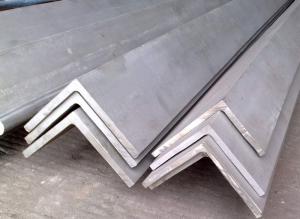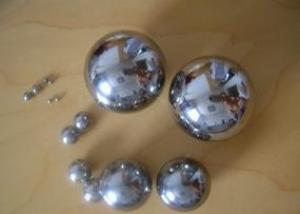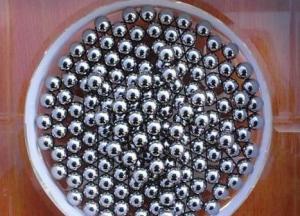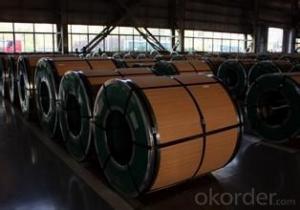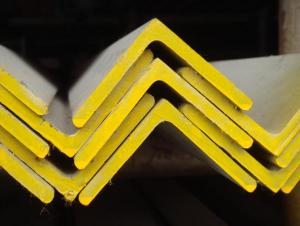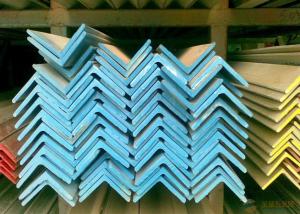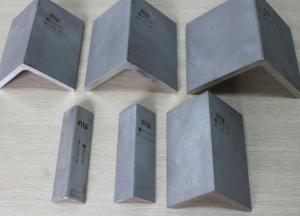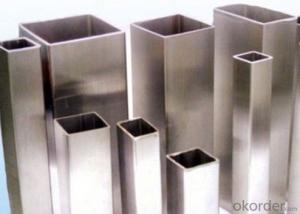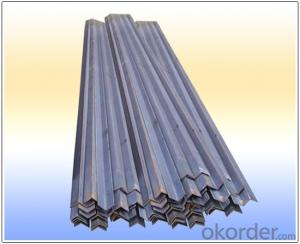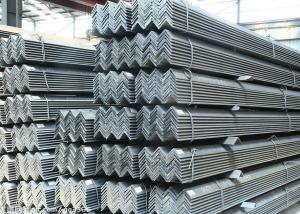Best Quality for Stainless Steel Angle
- Loading Port:
- China Main Port
- Payment Terms:
- TT or L/C
- Min Order Qty:
- 2MT m.t.
- Supply Capability:
- 5000MT Per Month m.t./month
OKorder Service Pledge
OKorder Financial Service
You Might Also Like
Details of Stainless Steel Angle:
Size mm | |
Width | Thickness |
25 x 25 | 3 4 5 |
30 x 30 | 3 4 5 |
40 x 40 | 3 4 5 6 |
50 x 50 | 4 5 6 |
60 x 60 | 5 6 7 |
65 x 65 | 5 6 7 |
70 x 70 | 6 7 8 |
75 x 75 | 6 7 8 9 |
80 x 80 | 7 8 9 10 |
100 x 100 | 8 9 10 12 |
Tolerance:GB4227, ASTM A276/A 484M, EN10056/DIN 1028 | |
Features of Stainless Steel Angle:
1. All products are made of high-quality imported raw materials.
2. Our products are certified by ISO9001:2008 authentication quality systems.
3. We are nominated as the AAA enterprise by Jiangsu government.
4. Quickest and most efficient Response to Your Enquiry.
5.Selected quality material
6.Finely processed
7.Prime quality&Bottom price
8.Complete in specifications
9.Abundant stock
Application of Stainless Steel Angle
Stainless steels of various kinds are used in thousands of applications. The following gives a flavour of the full range:
1.Domestic --- cutlery, sinks, saucepans, washing machine drums, microwave oven liners, razor blades
2.Architectural/Civil Engineering---- cladding, handrails, door and window fittings, street furniture, structural sections,reinforcement bar, lighting columns, lintels, masonry supports
3.Transport --- exhaust systems, car trim/grilles, road tankers, ship containers, ships chemical tankers, refuse vehicles
4.Chemical/Pharmaceutical --- pressure vessels, process piping.
5.Oil and Gas ---platform accommodation, cable trays, subsea pipelines.
6.Medical ---Surgical instruments, surgical implants, MRI scanners.
7.Food and Drink ---Catering equipment, brewing, distilling, food processing.
8.Water ---Water and sewage treatment, water tubing, hot water tanks.
9.General ----springs, fasteners (bolts, nuts and washers), wire.

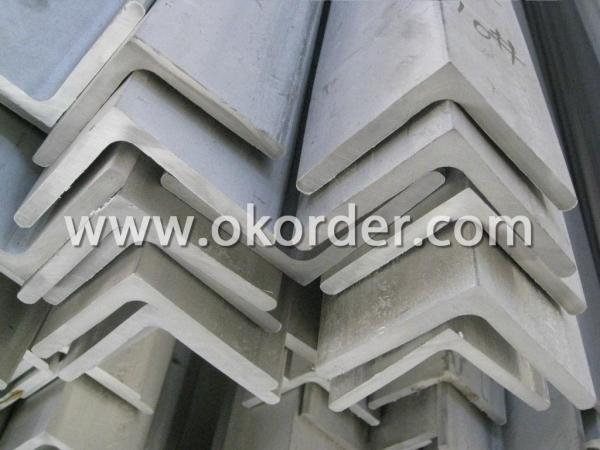
- Q:Can stainless steel angles be used in telecommunications infrastructure?
- Indeed, telecommunications infrastructure can incorporate stainless steel angles. Renowned for its resilience, resistance to corrosion, and robustness, stainless steel proves to be a fitting material for diverse uses within the telecommunications sector. Frequently employed to mount and sustain apparatus like antennas, satellite dishes, and communication towers, stainless steel angles contribute to structural steadiness and are capable of enduring inclement weather conditions. Consequently, they prove to be an ideal choice for outdoor installations. Furthermore, stainless steel angles can be effortlessly fashioned and tailored to meet particular project specifications, providing a malleable option for design and implementation.
- Q:How do I choose the right stainless steel angle for my project?
- When choosing the right stainless steel angle for your project, consider factors such as the grade of stainless steel, the dimensions and thickness needed, as well as the specific requirements of your project. Additionally, take into account the intended use and environmental conditions the angle will be subjected to, as this can impact the choice of stainless steel grade. It is recommended to consult with experts or suppliers who can provide guidance based on your project's specifications and requirements.
- Q:What are the surface finish options for stainless steel angles?
- There are several surface finish options available for stainless steel angles. These options provide different aesthetic appearances and functional properties to suit various applications. Some common surface finishes for stainless steel angles include: 1. Mill Finish: This is the standard finish that stainless steel angles come with after being manufactured. It has a dull appearance with visible lines or grooves caused by the manufacturing process. Mill finish angles are often used in structural applications where aesthetics are not a priority. 2. Brushed Finish: Also known as satin or dull polished finish, brushed stainless steel angles have a smooth and matte appearance. This finish is achieved by brushing the surface with abrasive materials, creating a uniform grain pattern. Brushed finish angles are commonly used in architectural and decorative applications where a visually appealing surface is desired. 3. Mirror Finish: As the name suggests, mirror finish stainless steel angles have a highly reflective surface that resembles a mirror. This finish is achieved through a polishing process that removes any imperfections, resulting in a smooth and glossy appearance. Mirror finish angles are often used in decorative applications, such as furniture, fixtures, and ornamental structures. 4. Bead Blasted Finish: Bead blasting involves bombarding the surface of stainless steel angles with tiny glass beads or ceramic particles to create a textured finish. This finish gives the angles a uniform matte appearance with a slightly rough texture. Bead blasted finish angles are commonly used in applications where a non-reflective surface is desired, such as industrial equipment or architectural elements. 5. Powder Coated Finish: Powder coating is a popular surface finishing technique where a dry powder is applied electrostatically to the stainless steel angles and then cured under heat to form a hard, durable, and colorful coating. Powder coated finish angles offer a wide range of color options and provide enhanced protection against corrosion, making them suitable for both indoor and outdoor applications. 6. Passivated Finish: Passivation is a chemical treatment process that removes surface contaminants and promotes the formation of a protective oxide layer on stainless steel angles. This finish enhances the corrosion resistance of the angles and is commonly used in applications where the angles will be exposed to harsh environments or chemicals. These are just a few of the surface finish options available for stainless steel angles. The choice of finish depends on the specific requirements of the application, including aesthetics, corrosion resistance, and functionality.
- Q:Can stainless steel angles be machined?
- Yes, stainless steel angles can be machined. Stainless steel is a versatile material that can be easily machined using various machining processes such as milling, drilling, turning, and grinding. However, it is important to note that stainless steel is a hard and tough material, which may require special tools and techniques for machining. Additionally, the presence of chromium in stainless steel can cause work hardening, which further increases the difficulty of machining. Therefore, it is recommended to use appropriate cutting tools, lubricants, and cutting speeds to ensure efficient and accurate machining of stainless steel angles.
- Q:What is the fracture toughness of stainless steel angles?
- The fracture toughness of stainless steel angles can vary depending on a few factors such as the specific grade of stainless steel, the manufacturing process, and the presence of any defects or impurities. Generally, stainless steel is known for its good fracture toughness, which refers to its ability to resist crack propagation and failure under applied stress. Stainless steel is often chosen for structural applications due to its high strength and toughness, making it suitable for withstanding heavy loads and impacts. However, it is important to consult the specific technical data or material specifications for the particular grade and condition of stainless steel angles to determine their fracture toughness values.
- Q:What are the different types of supports used with stainless steel angles?
- There are several different types of supports that can be used with stainless steel angles, including angle brackets, corner braces, L-shaped brackets, and structural steel beams. These supports help to provide stability and strength to the stainless steel angles, ensuring they can withstand heavy loads and maintain their structural integrity.
- Q:Are stainless steel angles resistant to atmospheric corrosion?
- Yes, stainless steel angles are highly resistant to atmospheric corrosion due to their chromium content, which forms a protective oxide layer on the surface, preventing rust and corrosion.
- Q:How do you clean and maintain stainless steel angle?
- Achieving cleanliness and proper maintenance for stainless steel angle can be accomplished by following a few simple steps. Initially, begin by using a soft cloth or sponge that has been dampened with warm water and mild soap to wipe down the surface. It is important to refrain from using abrasive cleaners or scrub brushes as they have the potential to scratch the stainless steel. After the cleaning process, it is crucial to thoroughly rinse the angle with clean water in order to eliminate any remaining soap residue. Subsequently, ensure that the surface is dried using a clean towel or cloth to prevent any water spots or streaks from forming. In the event that there are stubborn stains or fingerprints present, it is possible to utilize a stainless steel cleaner that has specifically been designed for this purpose. Apply the cleaner onto a soft cloth and gently rub it onto the surface, following the direction of the grain. It is imperative to avoid exerting excessive pressure or using circular motions, as this can also result in scratches. If there happen to be any rust spots on the stainless steel angle, it is recommended to gently scrub the affected area using either a stainless steel cleaner or a mixture of baking soda and water. Afterward, rinse the area and ensure that it is thoroughly dried. To maintain the stainless steel angle's shine and luster, it is advisable to employ a stainless steel polish. Apply a small amount of the polish onto a soft cloth and buff the surface, following the direction of the grain. This will aid in removing any smudges and fingerprints, while simultaneously providing a protective layer against future stains. In conclusion, regular cleaning with mild soap and water, combined with occasional utilization of stainless steel cleaner and polish, will effectively contribute to maintaining the cleanliness and overall pristine appearance of your stainless steel angle.
- Q:What are the different types of finishes available for stainless steel angles?
- There are several types of finishes available for stainless steel angles, each offering unique properties and aesthetic appeal. Some of the most common finishes include: 1. Mill Finish: This is the most basic finish, straight from the mill with no additional treatment. It has a dull, gray appearance and is often used in industrial applications where aesthetics are not a priority. 2. Brushed Finish: Also known as satin finish, this finish is achieved by brushing the stainless steel surface with a fine abrasive material. It creates a smooth, consistent surface with fine parallel lines, giving the angle a sleek and modern look. 3. Mirror Finish: This finish is achieved by polishing the stainless steel surface to a high shine, similar to a mirror. It requires extensive polishing and buffing to remove any imperfections, resulting in a highly reflective surface. Mirror finish is commonly used in architectural applications and for decorative purposes. 4. Bead Blasted Finish: In this finish, fine glass beads are blasted onto the stainless steel surface using compressed air. This creates a textured, matte appearance with a uniform pattern of tiny indentations. Bead blasted finish is often used in high-traffic areas or where a non-reflective surface is desired. 5. Powder Coated Finish: This finish involves applying a layer of dry powder paint onto the stainless steel surface and then baking it to create a durable, protective coating. Powder coating provides a wide range of color options and can be used to enhance the aesthetics and corrosion resistance of stainless steel angles. 6. PVD Coating: Physical Vapor Deposition (PVD) is a process where a thin layer of metal or metal alloy is deposited onto the stainless steel surface. This creates a decorative, durable finish with various colors and patterns. PVD coatings are commonly used in architectural and decorative applications. It's important to note that the availability of these finishes may vary depending on the manufacturer and the specific requirements of the project. Additionally, stainless steel angles can also be customized with specialized finishes to meet specific needs, such as anti-fingerprint coatings or anti-microbial finishes.
- Q:How do stainless steel angles contribute to earthquake resistance in construction?
- The unique properties and characteristics of stainless steel angles are crucial in enhancing earthquake resistance in construction. Firstly, the exceptional strength and durability of stainless steel make it an ideal material for seismic-resistant structures. By providing excellent structural support and reinforcement, stainless steel angles help distribute seismic forces evenly throughout the building. This is especially important in areas prone to earthquakes, where the ground motion can exert significant lateral forces on the structure. Secondly, stainless steel has a high tensile strength, allowing it to withstand substantial deformation without failure. During an earthquake, buildings undergo dynamic movements, including vibrations and lateral displacements. By acting as braces or connectors, stainless steel angles absorb and dissipate seismic energy, reducing the impact on the overall structure. Furthermore, the corrosion resistance of stainless steel is crucial for earthquake resistance. Over time, corrosion weakens a building's structural integrity, compromising its ability to withstand seismic forces. Stainless steel angles, being resistant to corrosion, provide long-term reliability and durability, ensuring the stability of the structure during earthquakes. Additionally, stainless steel angles are lightweight compared to other construction materials like concrete or masonry. This characteristic reduces the overall weight of the building, decreasing the inertia forces that act on the structure during an earthquake. Lower inertia forces result in reduced stress on the building, enhancing its seismic resistance. Moreover, stainless steel is fire-resistant, which is another important aspect of earthquake resistance. In the event of an earthquake, fires can be triggered by gas leaks or electrical faults. Stainless steel angles, being non-combustible, can withstand high temperatures and prevent the spread of fire, maintaining the structural integrity of the building. In conclusion, stainless steel angles significantly contribute to earthquake resistance in construction by providing strength, durability, and corrosion resistance. Their ability to absorb and dissipate seismic energy, along with their lightweight nature and fire-resistant properties, make them a valuable component in creating earthquake-resistant structures. Incorporating stainless steel angles in construction designs helps ensure the safety and longevity of buildings in earthquake-prone areas.
1. Manufacturer Overview |
|
|---|---|
| Location | Jiangsu, China |
| Year Established | 2010 |
| Annual Output Value | above US$3 million |
| Main Markets | East Asia, Middle East. |
| Company Certifications | |
2. Manufacturer Certificates |
|
|---|---|
| a) Certification Name | |
| Range | |
| Reference | |
| Validity Period | |
3. Manufacturer Capability |
|
|---|---|
| a)Trade Capacity | |
| Nearest Port | Shanghai |
| Export Percentage | 50% |
| No.of Employees in Trade Department | above 10 people |
| Language Spoken: | English, Chinese |
| b)Factory Information | |
| Factory Size: | about 50000 square meter |
| No. of Production Lines | above 3 |
| Contract Manufacturing | OEM Service Offered |
| Product Price Range | Average |
Send your message to us
Best Quality for Stainless Steel Angle
- Loading Port:
- China Main Port
- Payment Terms:
- TT or L/C
- Min Order Qty:
- 2MT m.t.
- Supply Capability:
- 5000MT Per Month m.t./month
OKorder Service Pledge
OKorder Financial Service
Similar products
New products
Hot products
Related keywords
